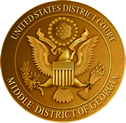

The Judicial Council / Administrative Office of the Courts has developed the Georgia Judicial Gateway (GJG) to facilitate access to numerous services provided by both public and private entities. This Portal is provided to enable Citizens and Court Professionals to access Vital Judicial Services throughout the State of Georgia. Please note that authentication may be required to access certain features/functions.
| Supreme Court | Court of Appeals | Superior Court | Probate Court | State Court |
|---|---|---|---|---|
| Nonpartisan election - six-year terms | Nonpartisan election - six-year terms | Nonpartisan election - Four-year terms | Partisan election of judges - Four-year terms | Nonpartisan election - Four-year terms |
Judges in Georgia are elected via nonpartisan elections. Judicial elections are held in Georgia in even-numbered years and take place on the primary date.[1]
Most court elections in Georgia are nonpartisan. Counties may choose to hold partisan elections for probate court positions. There are only judicial primaries for partisan elections.[1][2]
If no candidate receives a majority of the votes in the election (at least 50%+1 of the vote), a runoff election will be held between the two candidates with the most votes.[3]
If no candidate receives a majority of the votes in the election (at least 50%+1 of the vote), a runoff election will be held between the two candidates with the most votes.[3]
Federal courts have jurisdiction over cases involving:
For instance, a claim by an individual to receive money under a federal government program such as Social Security, a claim by the government that someone has violated federal laws, or a challenge to actions taken by a federal agency might all be heard in federal court.
In contrast, most family law matters are addressed in state court, since federal court jurisdiction granted by the U.S. Constitution does not include this area of law.
Few cases wind up in federal trial court, also called U.S. District Court. Judges encourage parties involved in a dispute to reach an agreement and avoid the expense and delay of a trial.
The impact of the federal courts on our lives is best known by landmark Supreme Court cases and other federal court cases that show the judicial branch is significant to the way we live and the rights we have.*
*From the About Federal Courts page
This section of uscourts.gov provides statistical data on the business of the Federal Judiciary. Specific publications address the work of the appellate, district, and bankruptcy courts; the probation and pretrial services systems; and other components of the U.S. courts.
The Federal Court System |
The State Court System |
|
Article III of the Constitution invests the judicial power of the United States in the federal court system. Article III, Section 1 specifically creates the U.S. Supreme Court and gives Congress the authority to create the lower federal courts. |
The Constitution and laws of each state establish the state courts. A court of last resort, often known as a Supreme Court, is usually the highest court. Some states also have an intermediate Court of Appeals. Below these appeals courts are the state trial courts. Some are referred to as Circuit or District Courts. |
|
Congress has used this power to establish the 13 U.S. Courts of Appeals, the 94 U.S. District Courts, the U.S. Court of Claims, and the U.S. Court of International Trade. U.S. Bankruptcy Courts handle bankruptcy cases. Magistrate Judges handle some District Court matters. |
States also usually have courts that handle specific legal matters, e.g., probate court (wills and estates); juvenile court; family court; etc. |
|
Parties dissatisfied with a decision of a U.S. District Court, the U.S. Court of Claims, and/or the U.S. Court of International Trade may appeal to a U.S. Court of Appeals. |
Parties dissatisfied with the decision of the trial court may take their case to the intermediate Court of Appeals. |
|
A party may ask the U.S. Supreme Court to review a decision of the U.S. Court of Appeals, but the Supreme Court usually is under no obligation to do so. The U.S. Supreme Court is the final arbiter of federal constitutional questions. |
Parties have the option to ask the highest state court to hear the case. |
|
Only certain cases are eligible for review by the U.S. Supreme Court. |
The Federal Court System |
The State Court System |
|
The Constitution states that federal judges are to be nominated by the President and confirmed by the Senate. They hold office during good behavior, typically, for life. Through Congressional impeachment proceedings, federal judges may be removed from office for misbehavior. |
State court judges are selected in a variety of ways, including
|
The Federal Court System |
The State Court System |
|
State courts are the final arbiters of state laws and constitutions. Their interpretation of federal law or the U.S. Constitution may be appealed to the U.S. Supreme Court. The Supreme Court may choose to hear or not to hear such cases. |
*Tables copied from Comparing Federal & State Courts - United States Federal Courts
 The Columbus Courthouse, which was built in 1934, is a 3-story building located at the corner of 12th Street and Second Avenue. The building houses the U.S. District Court, U.S. Marshal, U.S. Probation, and U.S. Post Office. The Columbus division serves Chattahoochee, Clay, Harris, Marion, Muscogee, Quitman, Randolph, Stewart, Talbot, and Taylor counties. The U.S. District Court is comprised of five divisions encompassing seventy counties in the state of Georgia with offices in Athens, Albany, Columbus, Macon, and Valdosta.
The Columbus Courthouse, which was built in 1934, is a 3-story building located at the corner of 12th Street and Second Avenue. The building houses the U.S. District Court, U.S. Marshal, U.S. Probation, and U.S. Post Office. The Columbus division serves Chattahoochee, Clay, Harris, Marion, Muscogee, Quitman, Randolph, Stewart, Talbot, and Taylor counties. The U.S. District Court is comprised of five divisions encompassing seventy counties in the state of Georgia with offices in Athens, Albany, Columbus, Macon, and Valdosta.
Street Address:
120 12th Street
Columbus, GA 31902
Mailing Address:
U.S. Post Office & Court House
PO Box 124
Columbus, GA 31902
706-649-7816 (voice)
706-649-7790 (fax)
columbus.ecf@gamd.uscourts.gov
| U.S. District Courts | U.S. District Courts |
|---|---|
| Georgia Middle Georgia Northern Georgia Southern |
Georgia Middle Georgia Northern Georgia Southern |
 Georgia Southern District Court
Georgia Southern District Court Tomochichi United States Courthouse (Headquarters)
125 Bull Street
Savannah, GA 31401
| U.S. District Courts | U.S. District Courts |
|---|---|
| Georgia Middle Georgia Northern Georgia Southern |
Georgia Middle Georgia Northern Georgia Southern |
 All of the Northern District of Georgia Federal courts.
All of the Northern District of Georgia Federal courts.
The Northern District of Georgia was established by Congress in 1849 and consists of forty-six counties (14,258 square miles) in the northwestern part of the state. The district, which includes the Atlanta metropolitan area, has four divisions: Atlanta, Gainesville, Newnan, and Rome.
| U.S. District Courts | U.S. District Courts |
|---|---|
| Georgia Middle Georgia Northern Georgia Southern |
Georgia Middle Georgia Northern Georgia Southern |